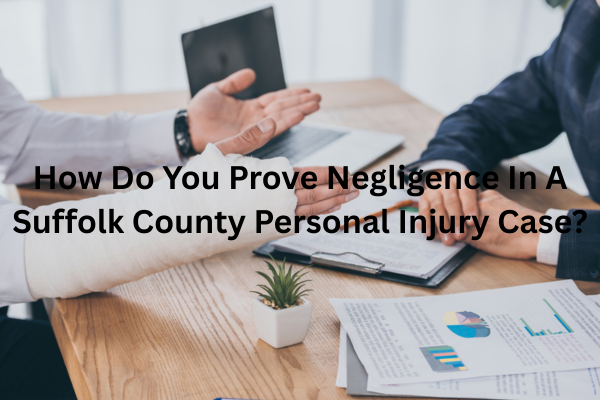

If you were injured in Suffolk County, proving negligence is the key that unlocks compensation. It is not about telling a dramatic story. It is about assembling facts, documents, and expert opinions into a clear picture that shows who owed you a duty of care, how that duty was broken, and how that failure caused real harm. Below is a practical, Suffolk-focused roadmap you can use to understand what goes into winning a negligence claim.
Every New York negligence case rises or falls on four elements: duty, breach, causation, and damages. Duty means the at-fault party had a legal responsibility to act with reasonable care, like a driver following traffic laws or a property owner fixing a known hazard. Breach is the failure to meet that duty, such as texting while driving or ignoring a broken handrail. Causation connects the breach to your injuries and requires more than speculation. Damages are the real-world losses you suffered, from medical bills to pain and lost income. Your case must check all four boxes.
Motor Vehicle Crashes: Drivers must operate their vehicles safely. Evidence of speeding, tailgating, failing to yield, intoxication, or distraction points to a breach. Traffic tickets and crash reports can be powerful, and violations of traffic laws often support negligence.
Premises Liability: Property owners and tenants must keep their properties reasonably safe. In slip or trip cases, the questions include whether the owner knew or should have known about a hazard and whether they had a reasonable opportunity to fix it or warn visitors.
Construction And Workplace Injuries: Safety rules and site protocols matter. Photographs, safety logs, and witness accounts help show when protective measures were missing or ignored.
Dog Bites Or Animal Incidents: Although New York law treats these claims differently than typical negligence, facts showing careless handling or failure to control an animal can still support liability theories in some circumstances.
Police And Incident Reports: For car crashes, obtain the police report and any supplemental diagrams or witness lists. For store or property incidents, ask for an incident report and the names of employees who responded.
Scene Photos And Video: Capture the scene as it was. For premises claims, that includes the lighting, the condition of the floor, warning signs, and surveillance camera locations. For vehicles, photograph damage, skid marks, debris, and the roadway.
Witness Statements: Neutral witnesses are persuasive. Get contact information at the scene, then follow up quickly while memories are fresh.
Medical Records And Notes: Prompt, consistent medical treatment ties the injury to the event. ER records, imaging, specialist notes, and therapy records all help prove the nature and extent of harm.
Digital And Device Data: Modern cases often turn on data. That can include vehicle event data recorders, phone usage logs around the time of the crash, point-of-sale timestamps, maintenance logs, and building management systems.
Preservation Letters: Send spoliation or preservation letters early to request that businesses, insurers, or municipalities keep surveillance video, vehicle data, and maintenance records. Video systems frequently overwrite in days, so speed matters.
Causation means showing your injuries flowed from the negligent act, not a pre-existing condition or an unrelated event. Medical timelines are crucial. If you started treatment immediately and your providers document new symptoms consistent with the mechanism of injury, it becomes much easier to connect the breach to the harm. In more complex cases, experts such as accident reconstructionists, biomechanical engineers, or treating physicians can explain how the incident produced your injuries.
Economic damages include medical bills, rehabilitation costs, prescriptions, durable medical equipment, and lost wages or reduced earning capacity. Keep pay stubs, tax returns, and employer letters verifying missed time. Save all out-of-pocket receipts.
Non-economic damages compensate for pain, limitations at home and work, loss of enjoyment, and the day-to-day ways your life changed. A recovery journal can be very helpful. Brief, dated entries about pain levels, missed family events, and sleep issues can make your experience real for an adjuster or jury.
New York follows pure comparative negligence. Even if you were partly at fault, you can still recover compensation, reduced by your percentage of responsibility. Insurers often lean on this rule to push blame your way. Solid evidence of duty, breach, and causation helps minimize any reduction by showing clearly who created the danger and how.
Municipal Defendants: If a town, the county, or a public authority may be responsible, strict deadlines can apply. Early investigation is essential to identify the proper entity and preserve rights.
Private Businesses And Chains: Many stores in Suffolk County have established risk management procedures and national counsel. Preservation letters, prompt requests for video, and careful communication can prevent important evidence from disappearing.
Medical Treatment Access: Keep your care consistent. Gaps in treatment are often used to argue your injuries were minor. If transportation is an issue, note it. If you switched providers, explain why.
Our team investigates immediately and methodically. We gather official reports, contact witnesses, secure video and digital data, and photograph the scene from every useful angle. We work directly with your medical providers to understand your diagnosis and prognosis, and when needed, bring in experts who can explain how the incident happened and why the other party is responsible. Additionally, we handle all communication with insurers so you can focus on recovery while we build the strongest possible record for settlement or trial.
Proving negligence in a Suffolk County personal injury case is a disciplined process. Establish the duty, pinpoint the breach, connect it to your injuries with credible medical proof, and present clear evidence of your losses. When these pieces align, liability becomes hard to deny and fair compensation becomes far more likely.
If you were injured anywhere in Suffolk County, Palermo Law can step in quickly to preserve evidence and build your case piece by piece. Reach out for a free consultation to talk through what happened, what proof already exists, and what we can do next to pursue the compensation you deserve.